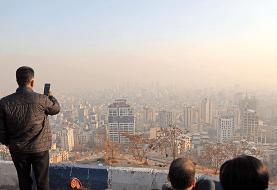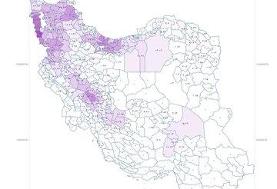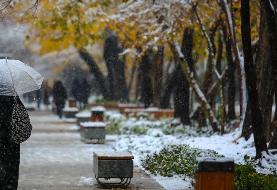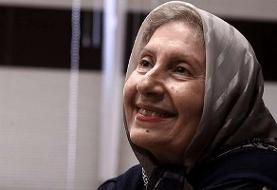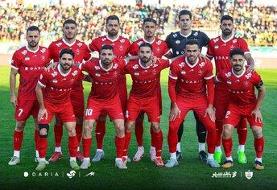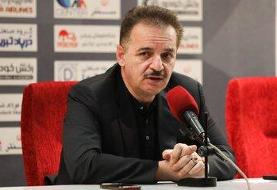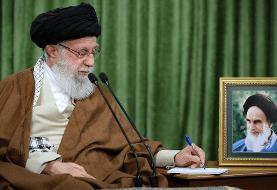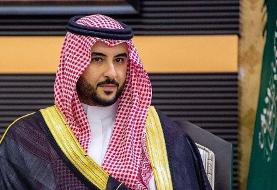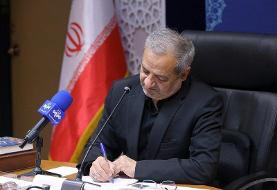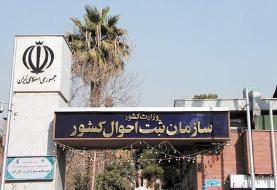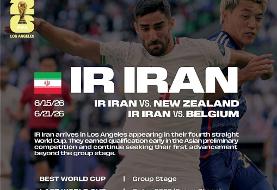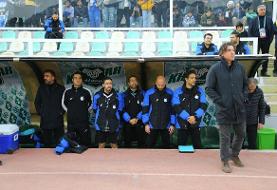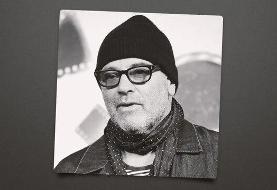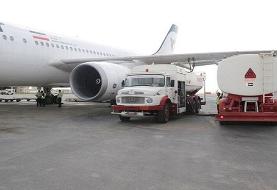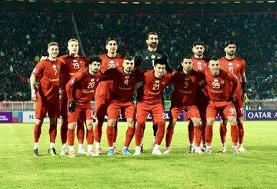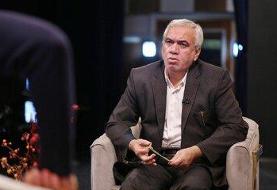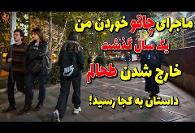لیلا فروهر
اخبار و مقالات
 ابی و گلزار در تهران و لس آنجلس خبرساز شدند (ویدئو)
ابی و گلزار در تهران و لس آنجلس خبرساز شدند (ویدئو)
 ویدئو: باز هم جنجال نام خلیج فارس و همکاری ابی و ...
ویدئو: باز هم جنجال نام خلیج فارس و همکاری ابی و ...
 ویدیو خبر: از فوت مرجان و سرقت مسلحانه مافیایی در مشهد ...
ویدیو خبر: از فوت مرجان و سرقت مسلحانه مافیایی در مشهد ...
 فیلم جنجال معلق زدن رضا پهلوی برای وزن کم کردن و عصبانیت ...
فیلم جنجال معلق زدن رضا پهلوی برای وزن کم کردن و عصبانیت ...
 ویدئو: ادامه جنجال کنسرت خوانندگان ایرانی در عربستان با ...
ویدئو: ادامه جنجال کنسرت خوانندگان ایرانی در عربستان با ...
 گوگوش ، لیلا فروهر و نوشآفرین کودکان کار بودند
گوگوش ، لیلا فروهر و نوشآفرین کودکان کار بودند
لیلا فروهر متولد ۴ اسفند ۱۳۳۷، بازیگر و خواننده ایرانی سبک موسیقی پاپ است. وی در خانوادهای هنرمند از مادری هنرپیشه به نام فرنگیس فرحزادی به دنیا آمد. وی از ۳ سالگی به نقش آفرینی در تئاترهای مختلف در تئاتر سپاهان اصفهان در کنار پدر و مادر خود و ارحام صدر پرداخت. وی از سن ۳ سالگی بر روی صحنه تئاتر به همراه پدر و مادر خود نقش آفرینی میکرد و در اکثر تئاترها با هنرمند بزرگ تئاتر ارحام صدر نقش آفرینی میکرد. او در سال ۱۳۴۴ با فیلمهای «مراد و لاله» و «خروس جنگی» وارد سینمای ایران شد و با سن و سال کمی که داشت از پرکارترین هنرمندان ایران بشمار میرفت تا جایی که به او لقب «کودک خردسال سینمای ایران» را دادند. از درخشانترین فیلمهای لیلا فروهر میتوان به فیلم سلطان قلبها به کارگردانی محمدعلی فردین اشاره کرد در ۵ سالگی اولین فیلم خود را به نام «مراد و لاله» و سپس در «خروس جنگی» بازی کرد. در کودکی در بیش از ۴۰ فیلم سینمایی نقش آفرینی کرد که معروفترین آنها سلطان قلبها با حضور محمدعلی فردین،آذر شیوا و... بود. چند سال بعد خواهر لیلا به دنیا آمد که او را فریبا نامیدند.

لیلا از ۳ سالگی کار هنری خود را آغاز کرد. در ۵ سالگی فیلم مراد و لاله، خروس جنگی نقش آفرینی کرد و سپس در ۹ سالگی در فیلم سلطان قلبها در کنار محمدعلی فردین بازی کرد.موفقیت و هنر لیلا در فیلم سینمایی سلطان قلبها تا حدی برای فردین دلنشین بود که تولد لیلا فروهر را در سندیکای هنرمندان برپا کرد. وی در فیلم من هم گریه کردم با بهروز وثوقی به نقش آفرینی پرداخت.
لیلا از ۱۴ سالگی خوانندگی را به طور حرفهای آموخت و خواند. و خالق آثاری از جمله شمیم، دو پرنده، کلاغهای خبر چین، قصه عشق شد.
او پس از انقلاب ایران، به دلیل ممنوعیت خوانندگی زنان، در لس آنجلس زندگی و کار میکند. او فرزند جهانگیر فروهر یکی از هنرپیشگان پیشین سینمای ایران است. مادرش فرنگیس فرحزادی نیز از بازیگران سینمای ایران به شمار میرود. لیلا پس از انقلاب به دادگاههای انقلاب اسلامی احضار شد.اما او در سال ۱۳۶۵ به ترکیه گریخت و سپس از آنجا رهسپار آلمان شد و پس از چهار روز راهی فرانسه شد که در آنجا مادر , خواهر و برادر خود را برای اولین بار پس از انقلاب ۵۷ ملاقات نمود, و سپس در سال ۱۹۸۸ به آمریکا مهاجرت نمود و ساکن شهر لس آنجلس شد و در آنجا نیز به خواندن در کنسرتها و تولید آلبوم جدید پرداخت.
قبل از انتشار آلبوم مخمل ناز وی خواستار تهیه و تولید آلبومی سنتی بود ولی به پیشنهاد همکاران و کمپانیها این پروژه را به تعویق انداخت و اولین البوم خود را با نام مخمل ناز به بازار عرضه کرد که موسیقی ترانه "ساقی" کار خود او بود. در پی عرضه آلبومهای موفق کنسرتهای زیادی در کشورهای مختلف در سراسر دنیا برگزار کرد.
لیلا فروهر اولین هنرمند ایرانی بود که برای اولین بار در دبی برنامه اجرا کرد و البته در کشور ژاپن نیز برنامههایی اجرا کرد و به دعوت تاجیکستان در شهرهای مختلفی چون: دوشنبه، کولاب،... برنامه اجرا کرد. در این برنامهها ۱۵-۲۵ هزار نفر حضور داشتند.
لیلا فروهر در سال ۱۹۹۶ آلبومی به نام "Plant Of Harmony" را بازار عرضه کرد که به بیش از ۹ زبان ترانه اجرا نموده از جمله ارمنی،انگلیسی،ایتالیایی،عربی، افغانی، اسرائیلی، ترکی، یونانی و ترانه های فولکلور ایرانی.
لیلا فروهر در ۱۹ آگوست ۲۰۰۴ بر روی کشتی عشق آغاز زندگی مشترکش با یک ایرانی موفق و یک چهره آشنا و محبوب و مطرح ایرانی با اسی نبی جشن گرفت و تا به امروز زندگی با عشق را همراه با همسر و خانواده اش سپری می کند
برگزاری مراسم بزرگداشت نوروز از جانب کمیسیون نوروز در تالار توماس جفرسون کتابخانه کنگره آمریکا و دعوت از لیلا فروهر به عنوان هنرمند و خواننده فارسی زبان یکی دیگر از موفقیتهای لیلا فروهر در عرصه هنری است.(کمیسیون نوروز سازمان فرهنگی و هنری است که از جانب ایرانیان مقیم آمریکا و سفرای آسیای باختری و مرکزی تشکیل شده و هدفش معرفی فرهنگ و سنتهای پارسی زبانان است). در این مراسم لیلا فروهر ترانههای آلبوم از قلب من را اجرا کرد در کنار لیلا فروهر شخصیتهای فرهنگی و هنری و سیاسی زیادی نیز حضور داشتند که میتوان به حضور رضا پهلوی نیز اشاره کرد.
یکی دیگر از کارهای لیلا فروهر اجرای دو برنامه در سالن مراسم اسکار تئاتر کداک میباشد. لیلا فروهر در سالهای ۲۰۰۳ و ۲۰۰۸ در این سالن برنامه اجرا کرد.
چند روز قبل از نوروز ۱۳۹۱ لیلا فروهر آلبوم از قلب من را منتشر کرد. در این آلبوم لیلا شعرهایی از شاعران ایران همچون مولانا، عراقی، فریدون مشیری، رهی معیری، سیمین بهبهانی، حافظ و... انتخاب کرده و با آهنگسازی و تنظیم گروه رومی اجرا کرد. در این آلبوم چهره سرشناس سینمای ایران شهره آغداشلو نیز همکاری کرد و دکلمههای ترانهها را به انگلیسی بر عهده گرفت که سبب هرچه متفاوتتر شدن این آلبوم گردید.
برای اولین بار لیلا فروهر آلبوم از قلب من به صورت زنده بر روی صحنه برد. لیلا فروهر به همراه گروه رومی و شهره آغداشلو با ارکستر ۲۶ نفری به رهبری امیر بدخش کنسرت زنده آلبوم را در سالن مجلل «رویس حال» بر پا کرد. شب عشق و عرفان و موسیقی ناب ایرانی پیشکش ایرانیان مقیم آمریکا شده بود.
Leila Forouhar (born April 16, 1961 in Isfahan, Iran) is an Iranian singer and actress who is popular in Iran, Tajikistan and Afghanistan. She immigrated from Iran after the Iranian Revolution since solo female singers were banned from singing. Since 1988, She has been in Los Angeles.
Career
Leila is the daughter of the latest Iranian actor Jahangir Forouhar. He had already established a solid background in the Iranian entertainment industry by the early 70s. Her father was to have a great influence on the future singer and she has spoken of this in detail in her interviews. She started following the foot steps of her father to movies, with her initiation beginning with the minor roles she played in various movies that were based mainly on the social issues of the Shah era. With time, she was able to secure a child star title and especially with the release of Soltaneh Ghalbhaa (King of Hearts), her fame had already spread to all three Persian countries. By her teenage years, she was already posing modeling shots for top fashion magazines along her work as an actress. Playing such various roles from the girl next door Ezteraab to a wanderer Three Sisters to a drug addict The Thirsty Ones, her image was well cemented in Persian society.
In 1974, Leila began a new direction to her career when she announced her break into the music industry. After a few voice tests, Leila was immediately given an opportunity to record an album. The instant best-seller titled Leila Forouhar recorded in Iran flew off the shelves in Afghanistan in less than a day. The music videos accompanying this album were TV stations' most requested for months, and to this day remain classics. Particularly the songs "Cheshma-e-Nour" and "Eshgh Mesle Atisheh" made headlines in distinct entertainment publications which raved about the new singing sensation. A huge success, it was praised as the greatest album introduced to the Afghan society by a female singer. So well was its reception that she immediately unseated the then favorite singer Googoosh as the most popular female singer. The young Leila which had been seen as a child star was dancing rhythmically to tunes that absorbed her early fans but critics as well.
A favorite of columnists who followed her every move to report to the enthusiastic public, she was the face of all glossy magazines in Afghanistan. Her hairstyle from "Cheshma-e-Nour" became for years the most sought after look in Kabul. This was the first time a patriarchal society had bestowed a female artist such affection. A survey conducted in the 70’s named Leila as every Afghan man’s Fantasy Mistress. A round of performances followed until Iran became entangled in political turmoil.
The Iranian Revolution based on religious ideology opposed any form of art that it deemed corrupt. A revolutionary court order named popular singers and actors (both male and female) to show up for a court hearing. In this Leila was the third person listed. It was well ingrained that these artists must renounce their careers or face legal consequences. Without any choice, many singers accepted the orders and withdrew to oblivion.
Move to the United States
In 1988 Leila and her family moved to the United States quickly establishing contact with Los Angeles based Iranian artists who had fled at the outbreak of the revolution. That same year, she released Makhmal-e-Naz and in 1989 Hedieh (The Gift). A phenomenal success, Hedieh was received with equal acclamation from both critics and fans. The hit song "Ey Dil" (Oh My Heart) became immensely popular, rekindling a craze similar to that brought on by pre-revolutionary favorite "Cheshma-e-Nour." Soon after an album a year kept fans on their edge. During the 90's she re-established her reputation as favorite female singer, often teaming up with other Persian artists to deliver numerous notable albums.
In 2005, Leila married a Los Angeles based Iranian-American businessman in a ceremony that included many colleague singers and entertainers. She is said to maintain a balance between her marriage and career. Covering three generations of admirers now, she is popular among fans of all ages, some of whom weren't even born when her first album was released.

Recent Involvements
Leila often performs in concerts around the world, and this she has continued since the early 90s. Her recent trip to Tajikestan for a concert is the latest update on her career. There she performed with Tajik singers Manija Dawlatova and Shabnam Suraya where all three were well received. Since her popularity among Tajiks, and specially Afghans, parallels that of the native singers of these two nationalities, her performances are celebrated events resulting in sold out avenues.
Legacy
More than thirty years after stepping into singing and more than forty years since her acting debut, Leila’s fame has survived the Islamic Revolution of 1979, the Iran-Iraq War, the subsequent exile of Iranian celebrities to the West, and the eventual obscurity of the firsts as a result of time. Unlike other exiled artists of her era who’ve become bitter and showed open resentment due to the misfortunes of political turmoil of the 70s, Leila’s resignation has made her one of the few who’ve accepted the ordinance of destiny. Material that has been written about her speak of her as one of the few artists who’ve refrained from artistic reproductions and based her style on originality since the start of her career. Despite the fact that the black-and-white films she acted have become prized classical archives, particularly among the new generations of the Persian speaking countries, her songs have retained their timeless lure (according to various radio stations who play some of her three decade old songs). She is referred to as an immortal figure in the realm of music and hence attributed such epithets as Fantasy Mistress, Queen of Pop (this title also attributed to Googoosh) and more recently The Iranian Sphinx.
Discography
- 1974: Leila Forouhar
- 1988: Makhmal-e-Naaz
- 1991: Hedieh (with Shahram Solati)
- 1992: Shaans
- 1992: Bahaaneh
- 1993: Hamsafar
- 1994: Do Parandeh
- 1994: Parandeha (with Mahasti and Shahram Solati)
- 1994: Attal Mattal (with Ebi)
- 1995: Tapesh
- 1996: Saraab
- 1997: Love Songs
- 1997: Planet of Harmony
- 1997: Dance Beat
- 1998: Love Story
- 1999: Ghahremananeh Vatan (with Andy and Dariush Eghbali)
- 1999: Didar (with Shahram Shabpareh)
- 1999: Yek Samado Do Leila (soundtrack from the play "Yek Samado Do Leila")
- 2000: Tasvir
- 2000: Let’s party (with Maxim & The Boyz)
- 2001: Story of Yours, Story of Mine
- 2003: Live in Concert at the Kodak Theatre
- 2005: A Kiss
- 2007: Maahe Man (My Moon)
- 2008: Maahe Man
Single Records Releases
- 1974: Delshoureh
- 1975: Yeki Yepoole Khoroos
- 1977: Zalzalak
- 1992: Amad az rah fasle zibaye bahar
- 1994: Telesm
- 1995: Nefrin( with Mekabiz)
- 1996: Zamin larzid
- 1998: Iran barande mishe
- 2001: Azadeh Irani
- 2002: Mosabbeb
- 2003: Sayad Nojva
- 2006: Music
- 2007: Iran Iran (with Omid)
- 2007: The Memories (Dedicated to Mahasti)
Filmography
- Mehmaan
- Soltaneh Ghalbhaa
- Aramesh dar Hozooreh Digaraan
- Baagheh Boloor
- Shabeh Aftabi
- Ezteraab
- Four Sisters
- The Thirsty Ones
- Morad & laleh
- Iman
- The Beauty Sin
- Golden Cage
- The Springtime Connection





















